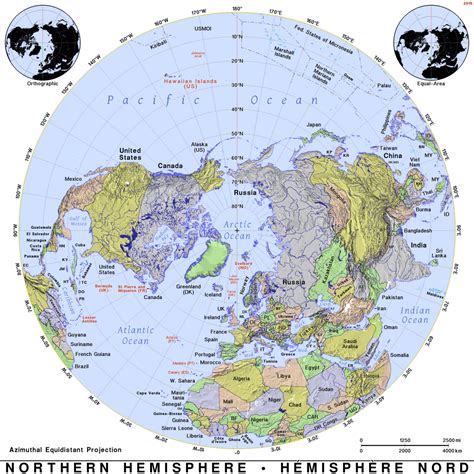Is Usa In The Northern Hemisphere
Kalali
Apr 02, 2025 · 4 min read

Table of Contents
Is the USA in the Northern Hemisphere? A Comprehensive Look at Geography and Hemispheres
The simple answer is a resounding yes, the United States of America is located entirely within the Northern Hemisphere. However, understanding this seemingly straightforward fact requires delving into the nuances of geographical definitions, the Earth's hemispheres, and the specific location of the USA's diverse geography. This article will not only confirm the USA's Northern Hemisphere location but also explore the broader context of geographical positioning and its implications.
Understanding Hemispheres: More Than Just North and South
Before we definitively place the USA, let's clarify what constitutes a hemisphere. The Earth is divided into two halves, or hemispheres, along two imaginary lines:
-
The Equator: This is an imaginary line circling the Earth midway between the North and South Poles, dividing the planet into the Northern and Southern Hemispheres. Any location north of the Equator is in the Northern Hemisphere, and any location south is in the Southern Hemisphere.
-
The Prime Meridian: This line runs from the North Pole to the South Pole, passing through Greenwich, England. Along with the 180th meridian, the Prime Meridian divides the Earth into the Eastern and Western Hemispheres. The lines of longitude measure distances east or west of the Prime Meridian.
The United States' Position: Firmly in the North
All 50 states of the United States, including Alaska and Hawaii, lie north of the Equator. Even the southernmost point of the continental US, located in Key West, Florida, is significantly north of the Equator. This makes the unequivocal statement that the USA is entirely situated within the Northern Hemisphere undeniably true.
A Look at the Extremes: Defining the Boundaries
To further solidify this point, let's consider the latitudinal extremes of the USA:
- Northernmost Point: Point Barrow, Alaska, lies at approximately 71° North latitude.
- Southernmost Point: As mentioned, Key West, Florida, is situated at approximately 24° North latitude.
Both these points are well above the Equator (0° latitude), confirming the USA's position within the Northern Hemisphere.
Beyond Latitude: Longitude and the Western Hemisphere
While the latitude definitively places the USA in the Northern Hemisphere, its longitude contributes to its placement in the Western Hemisphere. The majority of the continental US lies west of the Prime Meridian. However, some of Alaska's easternmost points extend slightly into the Eastern Hemisphere due to the curvature of the Earth and the International Date Line.
This highlights that a location can belong to multiple hemispheres simultaneously. For example, Alaska is both in the Northern and Western Hemispheres. This doesn't negate its primary placement within the Northern Hemisphere. The key factor remains its position relative to the Equator.
The Importance of Hemispheric Location: Climate and More
The location of the USA within the Northern Hemisphere has significant implications for various factors, including:
-
Climate: The Northern Hemisphere experiences distinct seasons due to the Earth's axial tilt relative to the Sun. The USA experiences four distinct seasons, with variations across its vast territory. The southernmost states have a subtropical climate, while the northern states experience colder winters and shorter growing seasons.
-
Daylight Hours: The length of daylight hours varies throughout the year depending on the latitude and season. Locations further north experience longer daylight hours during summer and shorter hours during winter.
-
Navigation and Mapping: Understanding hemispheric location is crucial for navigation, cartography, and geographical information systems (GIS). Accurate maps require the precise positioning of locations based on latitude and longitude.
-
Cultural and Political Implications: Hemispheric divisions have historically played a role in cultural and political interactions. The historical division between the Northern and Southern Hemispheres has influenced trade, migration, and geopolitical relations.
Dispelling Myths and Misconceptions
Occasionally, misconceptions arise about hemispheric divisions. Some might incorrectly assume that the USA is somehow partially in the Southern Hemisphere. This misconception could stem from a lack of understanding of the basic principles of geography or from a focus on specific geographical features rather than overall location.
It's crucial to emphasize that the overall position of a country or region is determined by its relationship to the Equator and the Prime Meridian. The existence of diverse climates and geographical features within a single country or region doesn’t alter its primary hemispheric placement.
Conclusion: The Unchanging Truth
The United States of America is undeniably and entirely located in the Northern Hemisphere. This is a fundamental geographical fact supported by the latitude of all its constituent states, from the Arctic reaches of Alaska to the tropical landscapes of Florida. Understanding this fundamental truth allows for a more complete comprehension of the country's climate, geography, and global context. This knowledge is crucial for a wide range of disciplines, from geographical studies to meteorology, navigation, and international relations. While understanding the nuances of longitude and the Western Hemisphere adds further depth to its geographical position, its primary location within the Northern Hemisphere remains a cornerstone fact.
Latest Posts
Latest Posts
-
How Many Ounces In 75 Cup
Apr 03, 2025
-
What Is The Molecular Geometry Of Seh2
Apr 03, 2025
-
Are The Ratios 16 8 And 2 1 Equivalent
Apr 03, 2025
-
48 Inches Is How Many Feet Tall
Apr 03, 2025
-
How Many Ml In 7 Ounces
Apr 03, 2025
Related Post
Thank you for visiting our website which covers about Is Usa In The Northern Hemisphere . We hope the information provided has been useful to you. Feel free to contact us if you have any questions or need further assistance. See you next time and don't miss to bookmark.
